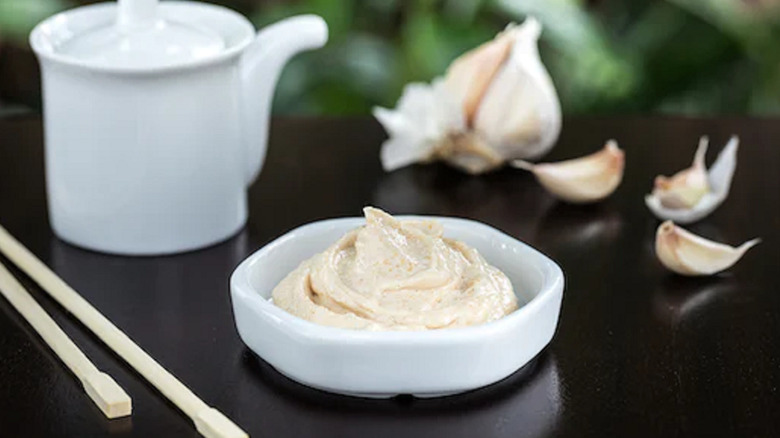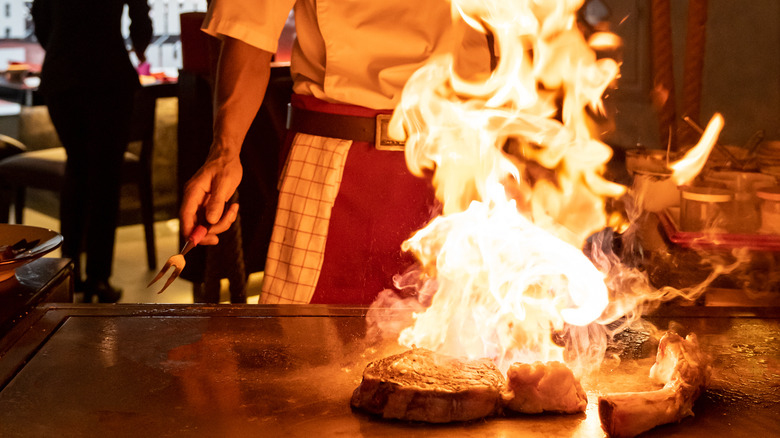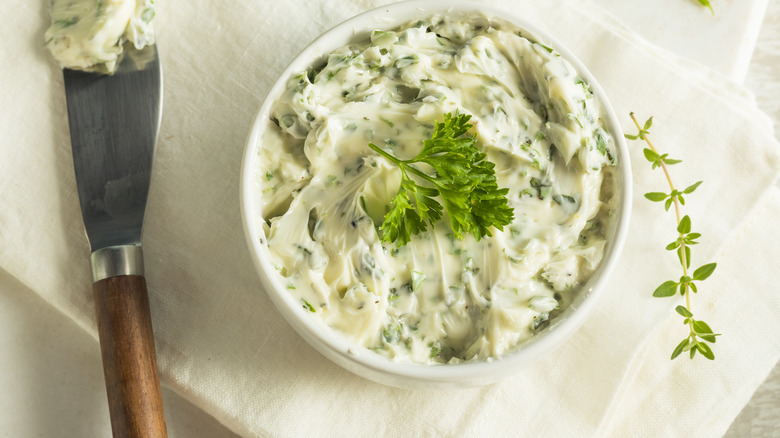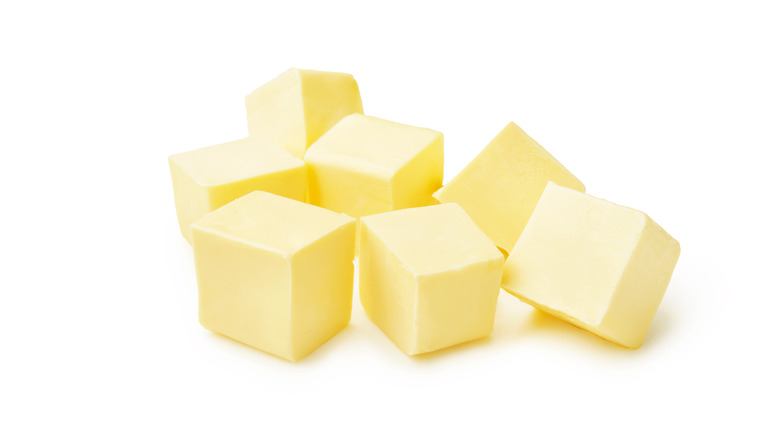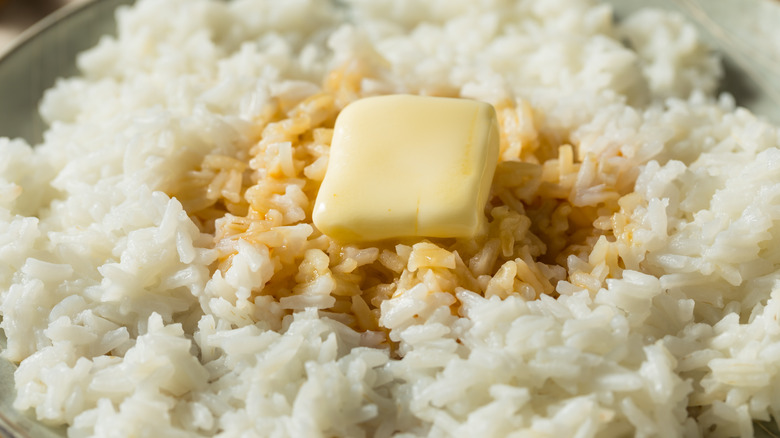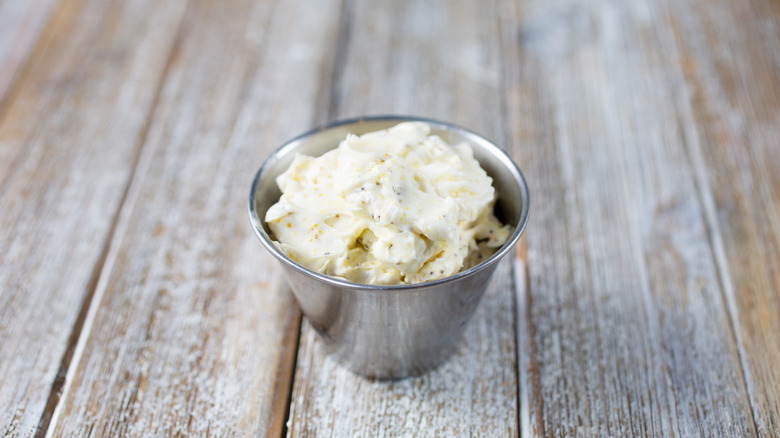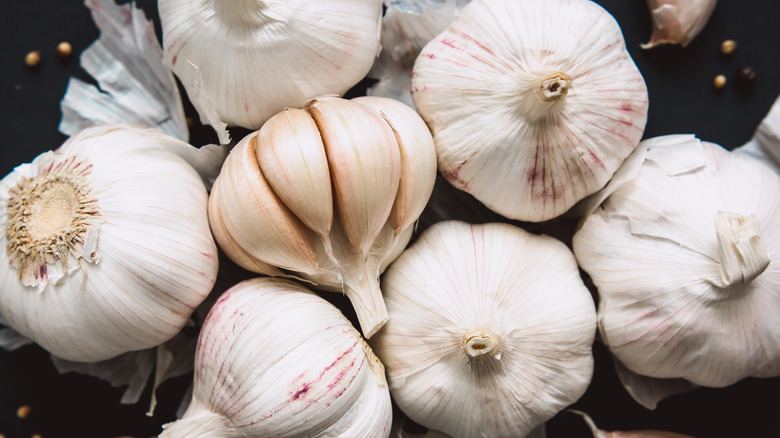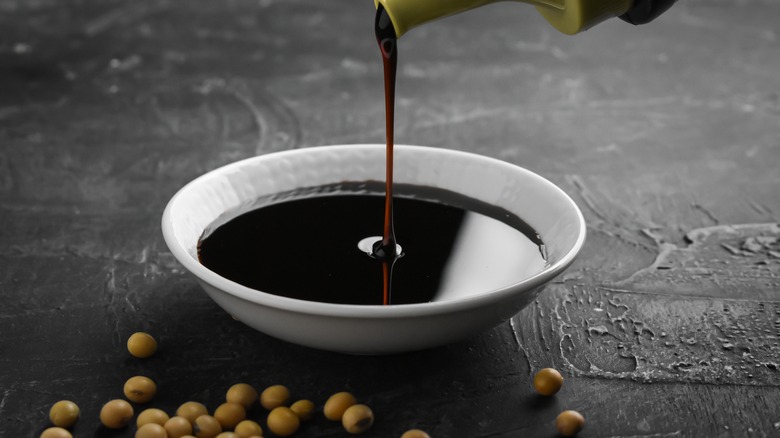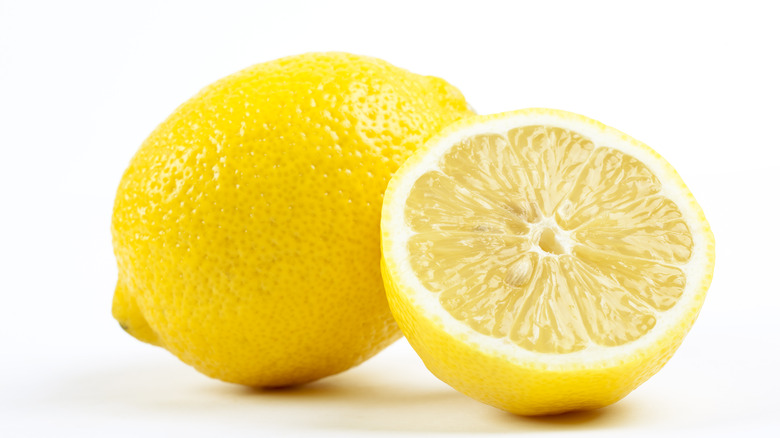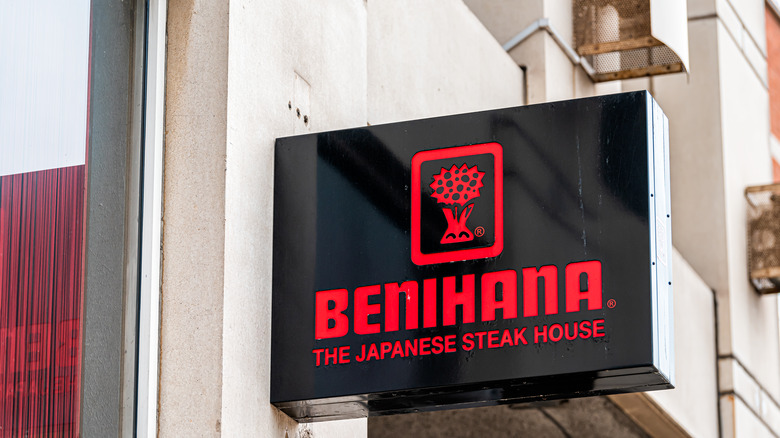The Secrets Behind Benihana's Garlic Butter
Benihana is a cult classic for a reason. Founded by former pro wrestler Hiroaki "Rocky" Aoki in Midtown Manhattan in 1964, the teppanyaki restaurant is best known for its quick-moving chefs who put on a true show for patrons sitting around the central grill. Today, the restaurant has become a well-known chain, encompassing 78 different locations around the world. Chefs at Benihana are known for their showmanship and theatrical approach to Japanese fare, with a menu boasting onion volcanoes, flying shrimp, and more. But despite the wow-factor of so many of the restaurant chain's dishes, perhaps no Benihana recipe is more coveted — or more frequently replicated — than the house garlic butter.
It might seem strange that garlic butter is such a staple of a Japanese restaurant, but in reality, it provides the base flavor of many of the dishes served at Benihana. It's no surprise that so many people have tried to get to the bottom of this somewhat secret recipe, but luckily, you need search no further. Here's everything you never knew you needed to know about Benihana's garlic butter.
At Benihana, they use a lot of garlic butter
The sizzle of Benihana's garlic butter is a major part of the flair of this teppanyaki restaurant, so it's perhaps no surprise that they use quite a lot of it. One reviewer writing for Business Insider took the time to note the sheer amount of butter that goes into the famous fried rice in her article, writing that the chef "dumped four or five heaping spoonfuls of butter" into the rice as it cooked.
"Suddenly," she continued, "I understood why people might like it."
Indeed, the reviewer said that following the primary flavor of rice, the secondary flavor of the dish was overpoweringly that of butter. Of course, for many diners at Benihana, this isn't necessarily a bad thing. One blogger, in seeking to create a "healthier" copycat recipe, praised the original fried rice recipe, noting, "If you guys know me, you know I freakin' love Benihana's fried rice." But even she said she needed to cut down on the butter for her version, opting to use ghee, a clarified butter alternative, instead.
They use it to add even more flavor to dishes, and so can you
At Benihana, garlic butter is used as much as a cooking fat as it is a seasoning. Indeed, the garlic butter may be most famous as the base for the chain's beloved fried rice, but it also pops up as the cooking fat for the grain-fed prime tenderloin, wagyu ribeye, and even the sautéed mushrooms. And that's no surprise. The butter doesn't just add sizzle — it also adds loads of flavor to whatever ingredient it kisses.
It's no surprise, then, that so many people have attempted to recreate it at home. Not only does having Benihana garlic butter in your arsenal mean that you can recreate some of the chain's famous dishes, but you can also experiment with it by using it to season other dishes. Benihana garlic butter makes exquisite garlic bread, is phenomenal when stirred into pasta, and makes your morning bagel a particularly delicious treat. (Though maybe not right before a staff meeting.)
At Benihana, the garlic butter might not actually be made with butter
While Benihana staff members — not to mention fans — regularly refer to the spread that, according to an Insider review, appears in a "large tub" at every station as butter, the reality is a bit less dairy-derived than that. According to a blogger writing about the Be the Chef program, a Benihana experience that allows amateurs to become teppanyaki chefs for a day, the tubs are actually filled with "European-style whipped butter blend margarine" — a clarification echoed by a Washington Post writer who puts "butter" in much-needed scare quotes.
"I can believe it's not butter, to co-opt a phrase, because it doesn't melt that way," she wrote following her own Be the Chef experience, noting that the "butter" is actually a margarine product made with skim milk.
If Benihana opts for margarine over butter, it's likely due to the cooking temperatures required for teppanyaki-style dishes. These tables frequently reach temperatures of between 200 and 250 degrees Celsius (392 to 482 degrees Fahrenheit). Butter's smoke point is 300 to 350 degrees Fahrenheit, meaning that real butter would render most dishes a smoky mess. Margarine, meanwhile, has a smoke point of 410 to 430 degrees Fahrenheit, making it a far more versatile ingredient for such high-heat environments.
The garlic butter at Benihana is not authentically Japanese
Authenticity is a frequently cited bugaboo when it comes to many Americanized iterations of foreign cuisines, and the garlic butter at Benihana is no exception. While butter is certainly trendy in Japan and appears in modern mochi treats, not to mention paired with ramen and rice to create a richer, creamier texture, garlic butter is not traditionally used in Japanese cooking. But according to Business Insider, that's par for the course for the Americanized Japanese restaurant, which has long sought mass appeal by "eliminating any flavors Americans might find offensive."
"Its food," the journalist wrote, "has a reputation for tasting nothing like Japanese food."
While the journalist noted that this is the case of almost all of the restaurant's dishes, from the yum yum sauce to the ice cream dessert, she takes a special strike at the garlic butter.
"On the cooking cart, there were Japanese cooking staples like soy sauce and sunflower oil," she wrote. "However, the large tub of garlic butter stood out to me as a distinctly American condiment."
Whipped butter lends the perfect texture for replicating the chain's ice cream
While home cooks are certainly welcome to opt for margarine should they choose, most bloggers looking to create a copycat Benihana garlic butter recipe instead opt for actual butter ... and not just any butter. Whipped butter is the base of choice for many home cooks, as it is known to more accurately replicate the product the restaurant dubs "ice cream."
Store-bought whipped butters, according to the USDA, should incorporate air for a final product that's lighter and fluffier than other butters. While you can buy whipped butter in most grocery stores, you can also make it at home by whipping 3 tablespoons of room temperature milk into 1 cup of room temperature butter with an electric beater. And if you have leftover whipped butter that goes gritty in the fridge, you can always rewhip it with a tablespoon or two of new whipped butter to regain its original texture.
The official Benihana garlic butter recipe calls for fresh garlic
One blogger who took part in Benihana's Be the Chef experience shared on their blog that not only is the house garlic butter made by hand every day, but it only includes three ingredients: fresh garlic, butter, and soy sauce. But most home cooks attempting to copycat its rich flavor don't start with fresh garlic, but with roasted garlic. Indeed, one blogger noted that even when it's sautéed in butter or oil, minced garlic will never develop as rich and luscious a flavor as roasted garlic will. Indeed, roasting garlic mellows its sharpness and brings out all of its depth and caramelized sweetness.
That said, different strokes for different folks. Another blogger — and, it must be said, another fan of the roasted garlic technique — notes that mashed garlic will impart a more intensely garlicky flavor, which might be even tastier for some palates.
"As everyone has different tastes," she wrote. "I suggest that you experiment with both to see which you prefer."
Soy sauce adds the perfect hit of umami
Despite its name, garlic is not the only ingredient flavoring the butter in Benihana's garlic butter recipe. Soy sauce is another backbone of the condiment, and it lends the salty notes that make most experts start with unsalted butter.
"The soy sauce gives that salt hit together with umami, which gives the butter that extra dimension," wrote one blogger. Umami, which is a Japanese borrow word sometimes translated as "the essence of deliciousness" is one of the core flavors, alongside sweet, sour, bitter, and salty. Umami is a certain type of savory found not only in soy sauce, but in Parmesan cheese or roasted tomatoes. And indeed, soy sauce adds a savory, irresistable richness and depth to Benihana's garlic butter. As for whether you use dark or light soy sauce at home, it's kind of up to you. Darker soy sauce is richer in flavor and also saltier, while light soy sauce adds a milder umami note.
Lemon juice is the secret ingredient that makes Benihana's garlic butter sing
After garlic and soy sauce, the third ingredient flavoring Benihana's famous garlic butter is lemon juice. This not-so-secret ingredient is crucial, lending the butter a touch of balanced acidity. Just a few drops should be enough to brighten up the otherwise rich condiment. It makes the garlic butter a particularly perfect pair with seafood, specifically Benihana's famous flying shrimp.
Be sure you use freshly squeezed lemon juice (none of that bottled stuff) for the best results. Fresh lemon juice doesn't have time to oxidize the way that the bottled variety does, and it also doesn't contain any preservatives. The result is a brighter flavor with no bitter or off flavors. And as an added bonus, if you use fresh lemons, you can take full advantage of the aromatic zest as another flavor agent or an aromatic garnish for your finished dish.
If you can't be bothered to recreate it at home, you can order it online
The Internet is rife with copycat recipes for those looking to recreate Benihana's famous garlic butter at home, and by all accounts, it's super simple to prepare. That said, if you can't be fussed to roast your own garlic or whip your own butter, there is another option. Benihana actually sells its butter online for $12 a pint, and you can also get it at participating Benihana locations. It may be pricier than making it at home, but if the chain is still keeping any secrets regarding this sought-after condiment, you won't have to suss them out if you buy it directly from the source. You may not have the griddle table in your living room, but you can recreate at least a bit of the Benihana experience at home — specifically, the garlic butter.
